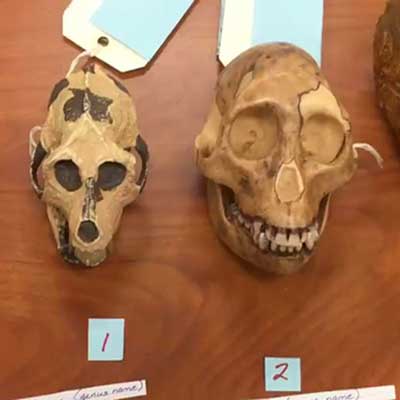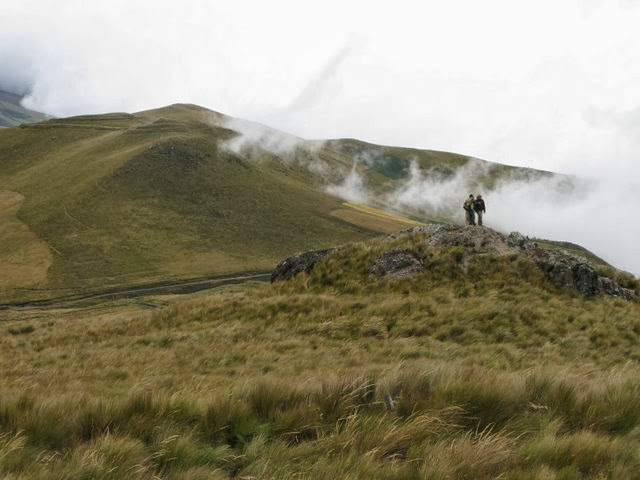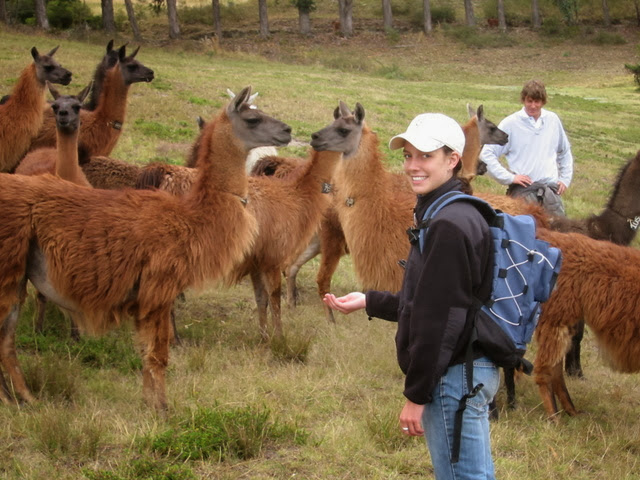
In The Field
Ecuador Program
Summer 2025 Field Program (6/28-7/18)
You want to be here. The community partners we work with are excited to have us return to continue the work. Our 2025 program will involve mostly local community service, reconnaissance and lab organization in July. Students would enroll in a 4-unit Applied Anthropology course that would allow for introductions to the region and development of future research plans.; and they will enroll in a 2-unit Laboratory Methods course that will cover the basics of artifact analysis as we continue to uncover clues to the legendary history of the area. Ecuador was a land of incredible resistance to colonial forces. Indigenous Quichua speaking peoples managed to hold off the Inka, the Spanish, and now multi-national coprorations since the 1400s. Is it the water? The climate? What is it about the peoples of the paramo (high grasslands) that gives them the ability to continue in the face of blatant imperialism.
If you are interested please fill out the preliminary application so we can contact you directly with more information. Thanks!
Below see the information from our 2 week program in 2023, the summer 2025 will be similar in structure.
PRELIMINARY 2025 APPLICATION HERE
Discover with us the beauty of Ecuador as we continue our investigation of the landscapes surrounding the Pre-Columbian sites of Pambamarca.Join us in South America this summer for an excellent archaeology and cultural experience with course work and field trips.
Live with us and other project members in the Andes.
Learn about all aspects of the research project, including archaeological survey and excavation and community development activities, but the focus will be on laboratory work.
Check out an informational video from Dr. Connell
Project Directors & Affiliated Professors
Samuel V. Connell, PhD (Foothill College)
Ana Lucía González, MA (Foothill College)
Chad Gifford, PhD (Columbia University)
Amber Anderson, PhD (SUNY - Buffalo)
Zev Cossin, PhD (American University)
What will you be doing in Ecuador?
- You will be living in the majestic Andes of South America at 10,000 feet
- You will be visiting incredible archaeological sites
- You will learn about a country by immersing yourself in the culture of a people.
- You will be at places you won't believe exist.
- You will be happy you came.
Daily Activities
Days will be spent immersed in the culture of Ecuador both past and present. To learn about the past the student will learn the basic field techniques of archaeology, including excavation, survey and laboratory analysis. Classwork will cover some archaeology methods and theory, as well as South American archaeology and history. For more details about our research and the past findings, please see the Pambamarca project website and the bibliography section below.
Field trips for students will be called Faculty Developed Practica (FDP) designed to foster intercultural knowledge. Students will be required to take part in these trips. For example students will travel to indigenous communities, market towns, ancient archaeological sites and museums.
We are a short ride to the town of Cayambe, and a little over an hour from Quito on the weekends. Also, the world famous artisans and market of Otavalo are located only a half hour to the north. Buses are cheap and direct. For the adventurous, the headwaters of the Amazon River, the majestic Pacific coastline, and even the Galapagos Islands are a short plane trip away. Ecuador is a truly remarkable place, and we are excited to share its wonders with you, and meanwhile to do some really interesting archaeology!
Description of the Archaeology
The Pambamarca project area contains the largest concentration of pre-Columbian forts in the New World (Hyslop 1990). We have been working here since 2001 excavating and surveying at the forts. We know from the Spanish chroniclers that the Inca Empire tried to conquer the Ecuadorian people beginning around 1490 and that the people of Ecuador put up a famous resistance which forced the Inca to construct fortresses over many years until finally the conquest ended in the murder of most of the Ecuadorian army at Lago Yaguarcocha or the Lake of Blood. The purpose of our study is to examine the sequence of occupation and activity in and around Pambamarca. What we have found out so far is that
- Evidence for warfare is everywhere
- People built these sites at different times and for different purposes.
- There are different kinds of sites in the Pambamarca complex, including castle-like pucara (Inca forts) and other non-military sites that seem to be more religious and less military.
- There are roads connecting all the sites.
- We need to learn so much more!
Our work in 2025 will continue researching these amazing sites and expand our survey in the Andean highlands. Our aim is to document all of the sites and find out why so many forts were built in this critical geographic location. In addition, we hope to uncover the differences between the Inka and Cayambe warfare tactics. Finally, we will be trying to understand what made the Cayambe so successful at resisting the Inka when the rest of South America fell so quickly.
Student field work typically begins at a Spanish era colonial hacienda where we learn field techniques, and quickly move to the other sites for the rest of the field season. Plans in 2025 will include analysis of artifacts from excavations at important Cayambe sites and Inka fortresses. Preliminary survey and exploration of ancient road systems will continue into the Amazon basin.
Students are trained in laboratory analysis this summer. Our typical student this summer may be someone with previous experience in survey and excavation who would like to be in the lab for a few weeks, or you simply want to come to Ecuador and learn about archaeology and anthropology! The project also utilizes Ground Penetrating Radar (GPR) to detect subsurface features and uses a Geographic Information System (GIS) to analyze data, but this summer we will not have the GPR in country, although we are planning a 3D photogrammetry project that students will be involved in.
Description of the Indigenous Anthropology
For too long archaeologists have been involving themselves in research without a coherent plan for using anthropology to work with the local peoples in different capacities. This summer we will be working closely with Ecuadorian community members who are interested in putting together a local museum. Students who are interested in aspects of public archaeology will be working closely with the project directors and the community members to create a shared vision for a permanent installation within the town of Cangahua. These are exciting times to be a part of the program.
Course Descriptions
All participants must commit to active and positive engagement in all program components. Students will earn 6 units of credit from Foothill College for successful completion of the program. The classes you will be taking are ANTH12 - Applied Anthropology (4-units) and ANTH17L - Intermediate Archaeology Laboratory Methods (2-units). Both of these courses are fully transferrable to your universities.
The field program is broken down into different parts and everything will be very accelerated. The field and lab training portions of the program involve all the aspects of archaeology, preparing the student to operate in a field archaeology environment anywhere in the world. Benefiting from the over 100 years combined staff experience in teaching archaeology, each student is instructed in methods of site reconnaissance, surveying, excavation techniques, data recording, photography, and drawing. In the laboratory, students are guided through different aspects of artifact analysis, such as ceramic typology and stone tool production experiments.
A field journal will be covering every day in the field will be handed in by the student to the professors. The journal will cover the research being conducted and critically analyze the experience as it is ongoing. We find it is important for our students to reflect upon the daily rhythm of their lives. We will also require one or two blog posts during the trip.
Food and Lodging
Foothill Program students will be residing in Pambamarca in the small town of Cangahua, which is located in the County of Cayambe on the northeastern limits of the Province of Pichincha (all about one hour north-north-east of Quito). The capital city of this county is also named Cayambe, which you will find on any map of Ecuador (Cangahua, however, doesn't always appear). Cangahua sits in the hills south of the city of Cayambe and it takes about 15 minutes to travel between them by bus. As you will discover, Cangahua itself is wonderful place to live-- small, open and enjoyable.
Participants will stay in a dormitory-styled house located behind the main church in the town of Cangahua. This ‘Casa Comunal’ is a large, two-story building with electricity, running water, showers, a kitchen, a mess hall and plenty of beds. When the project is up and running meals will be prepared for the project by two cooks that are hired from year to year. The food is excellent and super healthy! (imagine tasty quinoa pancakes)
If the idea of the dormitory-styled living in Cangahua is uncomfortable, students can elect (for extra cost) to stay in the Hacienda Guachalá. Check it out at www.guachala.com.
All ages are welcome from high school graduates to long ago retired. We believe in letting people go at their own pace. If you are concerned about your abilities to keep up with the group, please don't be worried.
Getting to Ecuador
All students will be arriving to Quito’s international airport on or before June 28th. If you arrive on June 28th a senior project member will be picking you up. If you arrive before June 28th you are on your own, but will be given detailed instructions for how to get to our main project living quarters. It is actually quite easy, and we are big proponents of arriving early and staying later as part of your adventure to South America. Most students make friends and decide to stay later traveling. You are already there so you might as well see the world!
Costs
The program fee for students is $2500 for the 21 day program. This money goes towards the transportation, food and housing in Ecuador, as well as all other costs of the project such as field trips. It is very reasonable and far less than most other programs. We are on the short side for program length, but we urge you to travel in country after our project, and this is inexpensive as well. You will also have to buy your own plane ticket and update your passport before coming to Ecuador. Plane flights have been around $600 for budget flights, which is again very reasonable.
Who Can Apply?
Anyone 18 or over can apply to the program.
We are asking for a working knowledge of SPANISH.
Often we have large programs of over 50 people, but this summer we are looking to run the program at a smaller size. We will be selective in our application process as there will not be as much space to accommodate students this year. We urge everyone to apply and we will let you know as soon as possible whether you have been accepted to the program.
Financial Aid
Financial Aid is available for Enrollment in a Study Abroad Program while attending Foothill College; foothill.edu/financialaid/apply.html Please make the aid office aware that you are doing the summer abroad program.
Contact information
Dr. Samuel Connell
Department of Anthropology
Foothill College
12345 El Monte Rd.
Los Altos Hills, CA 94022
USA
(650) 949-7197
connellsamuel@foothill.edu
DO NOT HESITATE TO EMAIL OR CALL IF YOU HAVE ANY QUESTIONS!!!
Project Web Sites
All the necessary information is found on the Pambamarca Website
Students from the today and the past are talking on the Pambamarca Facebook Page
Bibliography
Connell, Gifford et. al, "Hard Times in Ecuador." Antiquity. 77: 295. 2003.
D'Altroy, Terrence, The Incas (The Peoples of America). Blackwell Publishing, 2003.
Newson, Elizabeth, Life and Death in Early Colonial Ecuador. University of Oklahoma
Press, 1995.
Cieza de León, Pedro de, The Discovery and Conquest of Peru: Chronicles of the New
World Encounter. Durham and London: Duke University Press, 1998.
Athens, J. S., II, "Ethnicity and Adaptation: The Late Period-Cara Occupation in Northern
Highland Ecuador." in Resources, Power, and Interregional Interaction, edited by E.M.
Schortman and P.A. Urban. 193-219. New York: Plenum Press., 1992.
Hyslop, John, Inka Settlement Planning. University of Texas Press, 1990.
FAQ
Q. Who Can Apply?
A. Anyone with a high school diploma who will be 18 or over when we travel.
Q. Do I need to be an archaeologist?
A. Certainly not.
Q. Will there financial aid?
A. We are working on this through the Foothill Foundation and Financial Aid at Foothill.
ALL OTHER QUESTIONS CAN BE ANSWERED VIA THE PROJECT WEBSITE https://sites.google.com/view/pambamarca/home.

Questions?
We're Here to Help!
Anthropology Department
Sam: 650.949.7197
Kathryn: 650.949.7751
Julie: 650.949.7430
Samuel Connell
Kathryn Maurer
Julie Jenkins
Office 3017, Main Campus


